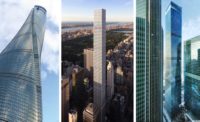Dear Editor of The New York Times,
(Yes, you read that right–this is an Editor’s Letter that’s a letter to an editor.)
Can it really be that in all the “Best of the Year” cultural coverage last month, the newspaper of record could not include a single work of architecture? The Times lists best movies, plays, dance, music, books. There even was a list called “The Year in Stuff,” which included a $2,145 Balenciaga handbag inspired by the 99¢ wrinkly blue plastic totes from Ikea. But no architecture.
So, at RECORD, we’ll fill the gap. Here are some top projects completed in 2017, in no particular order. Visit our website to view images of each.
1. Louvre Abu Dhabi, by Ateliers Jean Nouvel. For this big cross-cultural project, Nouvel had a key idea: simple clusters of white-box galleries—luxuriously finished—sheltered by an immense, hovering latticelike dome that admits dappled sunlight down to the indoor-outdoor complex. Voila!
2. 56 Leonard Street, New York, by Herzog & de Meuron. The skyscraper was arguably born in New York (despite what Chicagoans say), but it’s a building type that often seems to resist reinvention. So Herzog & de Meuron’s 57-story irregularly stacked Jenga-like tower is a welcome and dynamic addition to the Manhattan skyline.
3. Pierre Boulez Hall, Berlin, by Gehry Partners. Frank Gehry is a fan of Hans Scharoun’s swoopy-roofed Berlin concert hall, but his own contribution to the city’s music scene is a surprisingly simple and serene interior: an elegant elliptical form, clad in warm woods, for a 693-seat hall in Daniel Barenboim’s new conservatory, devoted to using music to bridge political and cultural divides.
4. Japanese Garden Cultural Village, Portland, Oregon, by Kengo Kuma and Associates. The Japanese architect’s first major work in the U.S., this exquisite trio of small buildings in the 20th-century Portland park employs elements from traditional Japanese architecture without succumbing to slavish replication.
5. Enigma, Barcelona, by RCR Arquitectes and Pau Llimona. If the architecture of a restaurant is meant to evoke its cuisine, the interior created by RCR, this year’s Pritzker Prize winners, with Pau Llimona, would give you no clue about what you were going to eat. The materials used to create the flowing, all-embracing, silvery-gray space with a cloudlike ceiling (manufactured sintered stone; squishy steel mesh) are as hard to identify as some of the ingredients in the exotic dishes served here.
6. Cornell Tech, New York, buildings by Morphosis and Weiss/Manfredi. Distinguished as much for the ideas behind it as the architecture, this campus expresses the new identity of a still-experimental pedagogical program for the digital age, combining graduate training and entrepreneurship.
7. Vijversburg Visitor Center, Tytsjerk, The Netherlands, by Junya Ishigami & Associates and Studio Maks. An amazing glass-walled pavilion, the structure has curving extensions that slither through a historic park in this small Frisian town.
8. Auditorium, Plasencia, Spain, by SelgasCano. Few architects play better with color and unexpected materials than this Spanish duo, who finally finished the interiors of this civic space, delayed by money problems, a decade after it was started. Clad in translucent ETFE panels, it looks as if a giant meteor has landed in a field on the edge of town, while inside, the stairs, walls, and floors are a riot of reds, oranges, and yellows.
9. Zeitz MoCAA, Cape Town, by Heatherwick Studio. Heatherwick’s main move in converting a former harborside industrial granary into a museum for contemporary African art was to carve enormous voids into the concrete grain silos, some as high as 200 feet, to create a towering atrium of immense vaults and curves, full of drama and mystery.
10. La Massana Fine Arts School, Barcelona, by Carme Pinós. The triumph of the building is not just in the angular forms that typify Pinós’s work but in the way its complex tailoring fits into a dense urban fabric while fronting a vibrant historic plaza that she also has redesigned.
Maybe next year, The New York Times can find some worthy architecture, and we’ll forgo the pricey handbag.
Meanwhile, happy New Year to all.
















Post a comment to this article
Report Abusive Comment